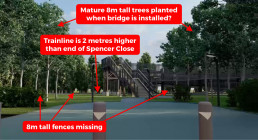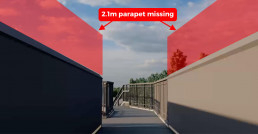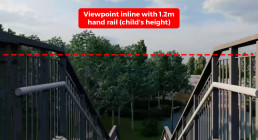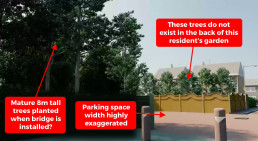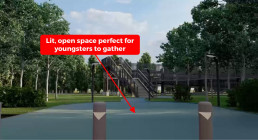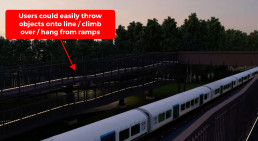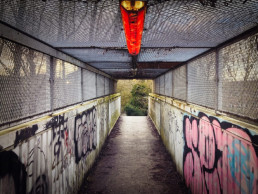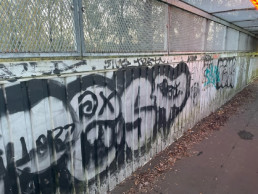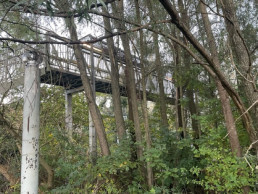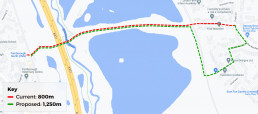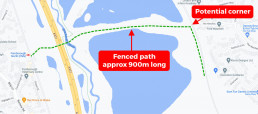Decision process
The “working cost” of £3.7m has gone up significantly from the original £2.4m quoted.
The proposed site is complex with nearby waterways, lakes, trees and wildlife to relocate so it’s reasonable to predict that this figure will rise.
Network Rail also have a reliance on purchasing third-party land (from the fisheries) in order to build the new pathway linking back to the original one west side of the Hatches crossing. Network Rail have not confirmed if this is included in this working cost.
Many residents have been very vocal about what they consider to be a grotesque misuse of funds. It’s particularly unpalatable in the current economic climate and with Network Rail strikes ongoing, many believe the funds could be better spent elsewhere.
Many residents find it difficult to understand why Network Rail are so set on a bridge when the cost continues to rise and when there is an alternative option in Miniature Stop Lights.
Miniature Stop Lights would increase the safety by approximately 60% on the existing level crossing but at a much lower cost, bringing it down to a level well below many other crossings on the network. It would also remove the need for whistleboards (the horn). The addition of alternative technologies, such as radar controlled obstacle detection will be available soon to further enhance crossing safety, certainly within the lifespan of the bridge and could be installed to further improve safety.
Throughout Network Rail’s risk assessment, consultation and website there seems to be an unbalanced representation of the pros and cons of the two solutions and many residents believe Network Rail have done this draw attention away from this option as there is little difference in their Cost Benefit Analysis scores.
During the final consultation, when questioned, Network Rail representatives were unwilling to say if Miniature Stop Lights would be the “Plan B” if the spiralling cost of the bridge becomes unacceptable. One Network Rail representative even said “they don’t work” which contradicts the 60% safety improvement quoted and used for their own risk assessment.
It also doesn’t align to the news that Network Rail are actively installing 90+ Miniature Stop Lights across Anglia between 2021 and 2024. Why is this solution suitable for each of these crossings but not at the Hatches?
Alongside the cost benefits of Miniature Stop Lights, many of the other concerns raised by residents and users would be addressed.
In the Narrative Risk Assessment – Cost Benefit Analysis, the bridge cost used for the calculation is £2.4m. This document, used to support the bridge solution, was approved in September 2022. Network Rail have previously confirmed in writing that the estimated cost for the bridge was £3m in October 2021 – almost a year before this document was approved (going up to £3.7m due to inflation).
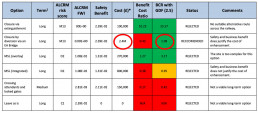
On this basis, it is difficult to justify why Network Rail are using an outdated cost in the Cost Benefit Analysis. If the correct figure of £3m was used (let alone £3.7m), the bridge option would fall below the threshold, failing the Cost Benefit Analysis and likely scoring lower that Miniature Stop Lights.
Network Rail have been asked to provide the formula to calculate the Benefit Cost Ratio to clarify how this would impact the bridge score, but this is yet to be provided.
When challenged, Network Rail were not able to justify this, other than to say that they need to draw a line in the sand at some point, but surely that point should be at the point of approving their own Cost Benefit Analysis? Network Rail representatives went on to say that improving safety was the main concern and the increased cost was secondary. This makes a mockery of the Cost Benefit Analysis and goes against Network Rail’s approach of “As Low As Reasonably Practicable”.
In the Narrative Risk Assessment, the “All Level Crossing Risk Model” (ALCRM) score used in the Cost Benefit Analysis gives the bridge options a perfect safety score as it only considers incidents that occur on a crossing. Of course this is not a true reflection of bridge safety.
One of the main threat to life risks is suicide. It would appear that bridges are a greater risk than crossings and that alone throws Network Rails claim into doubt. They have refused to provide any data on this. They have also failed to provide any other evidence regarding the wider risks related to footbridges (probably because it does not exist). Nonetheless, the claim that a bridge is safer has not been substantiated in any way.
To put level crossing deaths and suicides into perspective, Of the fatalities on the railway in 2019/20 6 occurred on a level crossing, 17 involved people trespassing on the railway, 283 were suicides or suspected suicides.
Here are some examples:
Deaths falling from a rail footbridge bridge (suspected suicides and uncertain circumstances)
- Berwick Hills, 2021
- Colchester 2020
- Eaglecliffe, 2000
- York, 2000
- Sittingbourne, 2017
- Smethwick Galton, 2015
- Colchester 2021
- Slade Green 2010
- Glasgow
- Durrington 2006
Injury
As we enter the winter months, how frequently (and who) will be ensuring the bridge is gritted and safe to cross? With approximately 300 users a day it’s not a high footfall, so surfaces will likely remain unsafe for longer or freeze over. If someone were to slip and fall down the steps (non Spencer Close side) there is the very real risk that they may not be heard or helped for some time.
When asked, Network Rail have not been receptive to installing security cameras, so it would rely on users or residents should any incident occur.
In the Narrative Risk Assessment – Incident history (2.10), there are eleven incidents listed over a four year period. Only two of these have occurred in the final two years period.
Of these eleven, only two reference needing to apply the emergency brake and they were both five years ago. On this basis, who decides what is considered a near miss / deliberate misuse? Surely this is subjective and could lead to crossings being classified based the opinion of drivers.
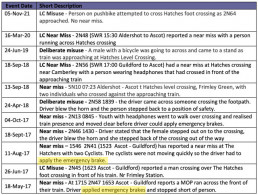
In the Narrative Risk Assessment – Crossing Usage (2.8), some information is provided about users but the census was conducted in a period when the country was recovering from the Coronavirus restrictions. On this basis, how true a reflection is this of pre or post pandemic?
Network Rail have shared no evidence to determine the motivations of the crossing users. No surveys or attempts to engage have been performed. Network Rail asserts around 300 crossings per day. For example, how many of these users are walkers or cyclist on a 10km circular route for whom a brief diversion via Frimley & Blackwater Valley path would be insignificant? How many of the crossers start and end their journeys in locations where the additional distance of travelling to Farnborough via Frimley or Hamesmoor Road would be deemed insignificant?
A proper survey of the users post pandemic is surely required to establish this before committing to such a huge and disruptive project.
In 2.8.7 it states “The types of vulnerable users are elderly, unaccompanied children, mobility impaired”, but when looking at the table of data, there are just thirteen elderly, one unaccompanied child and zero mobility impaired users over a nine day period. It’s difficult to understand why these groups are being emphasised.
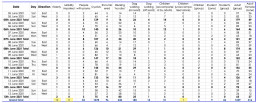
Fishermen are referenced on multiple occasions in the risk assessment. Whenever residents have raised concerns over fishermen parking, Network Rail have been keen to raise the point that won’t be an issue due to improved parking arrangements with the fishery. On that basis, including them in this report becomes irrelevant… or if there will continue to be fishermen using the crossing, the issue of parking needs to be addressed – Network Rail can’t pick and choose when to include them to support their argument.
Some of the visuals used in the Narrative Risk Assessment are misleading.
The images of a “reckless” crosser in the snow are time stamped and were taken on a day when the train line was closed.

Images of distracted / encumbered users in the consultation presentations are also difficult to substantiate. Network Rail have no way to determine if users wearing headphone have them turned on and if people wearing hoods are looking before they step out.
Ecological
Network Rail accepted that the preliminary ecological appraisal is not comprehensive and it was pointed out that disruption would affect everything from birds to adders (and bats, which were not mentioned but are seen in that vicinity regularly). This issue certainly needs more work and more transparency.
At a time of climate emergency, Network Rail are looking to remove approximately 1,200m2 of trees for this project. These trees are not only a good habitat but they screen the houses from the noise of the railway and the pollution caused by the trains.
Any replacement trees will likely be mature saplings which will take 20 years to provide adequate screening.
The area to be significantly affected by the bridge has been surveyed over many years by a local British Trust for Ornithology bird ringer and members of The British Herpetological Society.
There are many records of Adders and Grass snakes on the site. Adders are a protected species under the Wildlife and Countryside Act (WLCA) 1981 and a priority species under the UK Post-2010 Biodiversity Framework.
Roe deer, muntjac, foxes and badgers are often seen here.
The birdlife is exceptional and over 40 passerine species are regularly monitored. Over 7,000 birds have been processed here by the Frimley Ringing Group. These include protected species under the WLCA such as Kingfisher, Firecrest and Brambling. The site is important for Greenfinch, a species that is declining nationally and subject to particular viruses and was used for a study on the national impact of viruses on the species. The site is also used for national Winter Constant Effort Site monitoring of species for the British Trust for Ornithology.
The proposed route of the footpath and bridge footprint will obliterate the hedgerow where the majority of the birds are found. This native planted hedgerow was itself created for wildlife restoration as a result of the digging of the gravel around 40 years ago.
Consultation process
The consultation process has been poorly organised and communicated.
Prior to the first consultation, all communication referenced “The Hatches”. There was no indication that the proposal was to relocate the crossing to Spencer Close – important information to know when deciding to go to a consultation or not. Residents raised this with Councillors and they in turn shared this feedback with Network Rail, but this was not taken on board.
The first public meeting was extremely poor. The presentation was difficult to see and hear and attendees and Councillors had to push Network Rail to have a Q&A session. Network Rail representatives were unable to answer a large number of questions in satisfactory detail and there was no safety representative from Network Rail – rather important when the whole reason for updating the crossing is on safety grounds! This consultation was held in Frimley Community Centre, so anyone without access to a car would have found it harder to attend this.
The second consultation was better organised but there were access issues – the main doors were locked preventing entrance prior to the start. There was more detail available, but there was still a lot missing around the safety / risk calculations that underpin Network Rail’s decisions.
At none of the consultations did Network Rail count attendees or note any objections. There was no means to record their comments – there should have been forms for people to leave comments at each event.
We have been guided to use the website which is not accessible for everyone and those that do, can only provide feedback and questions via email.
A cherry picker was promised to show how tall the bridge would be. This was cancelled at the last minute and then a new meeting arranged. Publicity for this meeting arrived a couple of days before the event despite being dated over a week before. This is too short notice when people are working.
Network Rail did not rearrange this due to the winter / darker evenings and instead commissioned drone footage as a replacement. No footage has yet been shared and even when it is, Network Rail have said that the drone could not be positioned accurately as it would be too low / near the trees, making this whole process pointless and the concerns have not been addressed.
Residents believe Network Rail have settled upon the footbridge as the only solution to the crossing (with a clear overriding agenda of removing as many level crossings on the network as possible to reduce Network Rail’s ongoing maintenance costs thereby shifting all costs & liability for injuries onto local council/government), then proceeded with a consultation process that could never have had any influence on the company’s plans.
Network Rail has not taken on board a single concern or consideration from the local residents. Nothing that has been said in any of the consultations has had any material effect on the plans whatsoever beyond a vague acknowledgement that they would look into lighting and the maturity of planted trees.
Residents feel the consultation process have been a box ticking exercise and nothing more.
The visualisations and video created by Network Rail provide a misleading representation of the bridge. They have been very selective about what is included (and excluded) and some of the angles and proportions used are unrealistic. These are listed below:
- Network Rail have chosen to exclude the fence to the South (left) of the entrance which would be required to prevent trespassing on the open land.
- They haven’t include the 2.1m parapet across the bridge. Which will clearly impact the appearance and make it more enclosed.
- The fences parallel to the track are at waist height – presumably these would be much higher in reality.
- The viewpoint height throughout the video is from below the hand rail, so in no way realistic of an adult. To show this whilst talking about “overlooking residents” is strongly misleading.
- The land looks totally flat in the video, when in reality the train tracks are a couple of meters higher, meaning the entire bridge will be higher up.
- Rows of mature trees have been strategic positioned to block the view to resident’s gardens. It seems extremely unlikely that this would be the reality from day one, and if it is, I suspect the cost to plant and maintain these would be high.
- It shows Spencer Close as a wide clear road which it is not. It is a small cul-de-sac with potholes and cars parked along its length. It further shows land being utilised which is not in the control of Network Rail.
Residents have been extremely disappointed by the speed in which Network Rail share information outside the consultations.
A number of residents have found getting a response (or acknowledgement) to questions and information requests via email slow and cumbersome. Some requests have taken in excess of six weeks to get a reply.
Network Rail have put up a web page (as requested), but are using it as a promotional tool rather than an open and transparent source of information. They are only sharing the information that supports the bridge – none of the questions which reflect badly have been added even after multiple requests. There is continued delay on this and now we are being told there is a limited number of questions that can be added which is farsical.
The only method of “having our say” on the website is via email, meaning Network Rail are able to control what and when it is shared. There is little visibly to these responses as it’s all done via email – as to the previous point they are being selective of what they then share.
Impact on residents
Residents are extremely concerned about the prospect of having a bridge which is over eight metres tall so close to their homes. The three homes at the end of Spencer Close will be most impacted by this and Network Rail’s promise of tree walls and privacy parapets do little to appease these concerns.
Network Rail have created a visualisation that actually shows residents would be even more overlooked than previously feared. The viewpoint from the top of the steps is unnaturally low and hasn’t considered the train tracks are a couple of meters higher, meaning the entire bridge will be higher. Rows of mature trees have been strategic positioned to block the view to resident’s gardens. It seems extremely unlikely that this would be the reality from day one, and if it is, I suspect the cost to plant and maintain these would be high.
One of the families who will be overlooked have even greater reason to be concerned. Their son is 18 and has severe ASD (Autism Spectrum Disorder) and ADHD. He has communication difficulties, and his levels of understanding are low for his age. These age ranges are 5-7.
The Autism means that the world can be a very frightening place for him. He sees home as his refuge where he can relax and be in his own little world. Any changes to his surroundings can cause him great distress which then causes the family distress. He loves his trampoline in the garden as it is so quiet there he can spend hours in the garden even just sitting on the trampoline. Their main concerns are if he feels he is being observed or hears people or different sounds he won’t go out in the garden. With his ADHD he uses his trampoline to release all his built pressure. If he can’t do this properly, he can get aggressive and very anxious.
If the building of the bridge goes ahead this will also cause them grief as he has sensitivity issues with noise so would need notice when work will be done so they can prepare him and make other arrangements.
On the visualisation it shows a large number of mature trees would need to be removed to cater for the bridge. These trees currently act as a buffer to reduce the noise of the passing trains. Removing them directly at the end of the road would increase noise levels along Spencer Close.
Network Rail have indicated that lighting will be provided throughout the night, being triggered by motion sensors to prevent light pollution during these hours.
In the Narrative risk assessment (2.9.8) they state that the crossing has a high amount of usage during the night. On average 97 people use the bridge between midnight and 6am.
Residents are extremely concerned by the prospect of lights going on and off almost 100 times each night during these antisocial hours and the impact it could have on them.
Local residents are concerned there will be an increase in crime and antisocial behaviour due to the bridge.
On the visualisation, the pathway leading up to the bridge is well lit and vast, so makes a great area for youngsters to gather at all hours. The ramps and steps will also no doubt provide an attraction for youngsters to climb, skateboard and cycle down. This then becomes an intimidating prospect for users, but also an ongoing nuisance to local residents.
There is also the concern that properties along Spencer Close and adjoining streets could be targeted by burglars and opportunists. The street has always been a quiet cul-de-sac, with no through traffic, so having 300 users passing through will change the dynamic significantly.
There was an incident as recently as May 2021 on the Hatches where there was criminal damage and theft – Facebook article.
When asked, Network Rail have not been receptive to installing security cameras and have provided no evidence to support their argument that there would be no negative impact.
Residents are concerned about increased littering on the route and particularly around the bridge. When questioned, Network Rail have given no indication that any bins would be installed, they have only indicated that the bridge parapets would prevent people from littering onto the line – although it would appear that this would still be possible from the ramps unless the intention is to add parapets to these too?
Regardless, the parapets obviously don’t prevent users from dropping litter anywhere else around the bridge and it appears that Network Rail don’t consider this an issue or their responsibility.
Residents are concerned that users of the bridge and fisheries will start to park along Spencer Close, Bedford Crescent and Winston Close. Network Rail have been quick to dismiss such concerns, suggesting that fisherman will park in the fisheries car park going forward. In depth analysis of this matter must be undertaken to support this theory. The lives of those living in these quiet roads could be severely impacted.
Network Rail indicated that parking permits could be introduced along Spencer Close, but this itself comes with many negatives and only pushes the problem to neighbouring streets.
The appearance of the bridge will be completely out of keeping with the location and, as it is positioned directly at the end of Spencer Close, will become an eye sore. There has been no attempt by Network Rail to take onboard feedback about moving the bridge further South (to the left), so it’s not in direct view or overlooking the street.
Residents are concerned the bridge’s appearance will further deteriorate from graffiti. This example of a Network Rail pedestrian bridge is a mere 2.5 miles away in Crabtree Park, Camberley. This demonstrates Network Rail are either incapable or not interested in maintaining these infrastructure projects once they are in place.
Another concerning example of Network Rail’s footbridge maintenance is this incident at Kennedy Road, Barking from August 2022. The floor of the footbridge collapsed and a user fell landing close to the line. Fortunately his injuries were not life-threatening. View ITV News article and video.
Impact on users
In diverting the current bridlepath, the distance to get from the top of the Hatches to Farnborough North increases by approximately 0.5km. In short, it roughly doubles the walking time to the station and, proportionately, has an even bigger impact on leisure walkers, dog walkers and fishermen who may not go as far as the station. So there is a good case that it would be substantially less convenient.
At a time when councils are being encouraged to promote public transport, cycling and walking, the additional distance, time and inconvenience of ramps could drive users to alternative methods of transport.
Network Rail’s Narrative Risk Assessment (2.8.5) identified 1,078 cyclists use the existing crossing over a 9 day period. It also says that many cyclists do not dismount (2.4.4 / 2.8.9). It seems highly probably that these same cyclists who struggle through the gate without dismounting will do the same on a bridge, in doing so create a risk to themselves and any other users they may encounter on the bridge.
As we enter the winter months, how frequently and who will be ensuring the bridge is gritted and safe to cross? With approximately 300 users a day it’s not a high footfall, so surfaces will likely remain unsafe for longer or freeze over. If someone were to slip and fall down the steps (non Spencer Close side) there is the very real risk that they may not be heard or helped for some time.
When asked, Network Rail have not been receptive to installing security cameras, so it would rely on users or residents should any incident occur.
There have been some concerns raised around how safe people will feel using the longer path.
The current path is straight giving good visibility of oncoming walkers and cyclists and has fences along both sides. At night there is lighting along it. The new path going from Spencer Close to join the existing Hatches path would appear to create a bend (based the visuals provided in the consultations). This bend would likely reduce visibility of any oncoming walker or cyclist.
The full length of the fenced off pathway between Farnborough North and Spencer Close would be approximately 900m with no exit along it, so if there was to be an accident / incident it would take help significantly longer to arrive.
Network Rail’s Narrative Risk Assessment (2.8.5) identifies a large number of lone female users (416 over 9 days) and so this needs to be a consideration. If users do not feel safe using the pathway and bridge (particularly at night), they will look for alternatives.
When asked, Network Rail have not been receptive to installing security cameras, so it would rely on users or residents should any incident occur.
Planning application
Residents strongly oppose the possibility of a joint application for both the Farnborough North and Hatches (Spencer Close) bridges. Presumably the rationale here is to try to mask the many issues with the Hatches project and push it through with the Farnborough North project which clearly offers safety (and convenience) benefits to a much larger user base.
These are two very different crossings with different user needs, behaviour and numbers. They are also totally independent of one another i.e. one could be built without the other and it wouldn’t have any impact.
Do you oppose Network Rail's bridge proposal?
If you don’t agree with what Network Rail are proposing, there are things you can do.
Doing nothing will be seen as a positive response by Network Rail.

